Piet Mondrian was a Dutch painter born on 7 March 1872 in Amersfoort, the Netherlands. He attended the Rijksakademie van Beeldende Kunsten art school in Amsterdam and later became a member of the De Stijl group. His work is characterised by geometric patterns of rectangles and squares, interspersed with black and white lines with touches of primary colours. This stylistic choice was strongly influenced by orthodox neo-Platonic philosophy and other factors such as jazz music and the philosophical writings of Pieter Corneliszoon Hooft. Much of his work was deeply spiritual to him; many believed that he was trying to capture the essence of being in his paintings. In addition, he used an assemblage technique to create his works, which involved layering thin sheets of tracing paper on top of each other until the desired effect was achieved. Piet Mondrian died on 1 February 1944 in New York at the age of seventy-one. His legacy lives on in his iconic style, still much admired today, which has inspired many modern abstract painters around the world.
1. Composition in Red, Yellow, Blue and Black

Piet Mondrian is well known for his innovative approach to abstract art, which combines aspects of cubism with the later movement of modernism. His painting Composition in Red, Yellow, Blue and Black is a good example of how these different forms were synthetically blended. This minimalist masterpiece uses bold shapes in bright colours to create a composition that forms an almost musical rhythm according to visual harmony and rhythmic balance. This balanced element makes the painting both simple and very attractive, while the combinations of shapes and colours evoke strong emotions in the viewer. It is a magnificent work that captures and immortalises the success of Mondrian's artistic genius.
Date of the work : 1921
Original dimensions : 59.5 × 59.5 cm
Place of conservation : Nagoya City Museum of Art
2. Composition II in red, blue and yellow
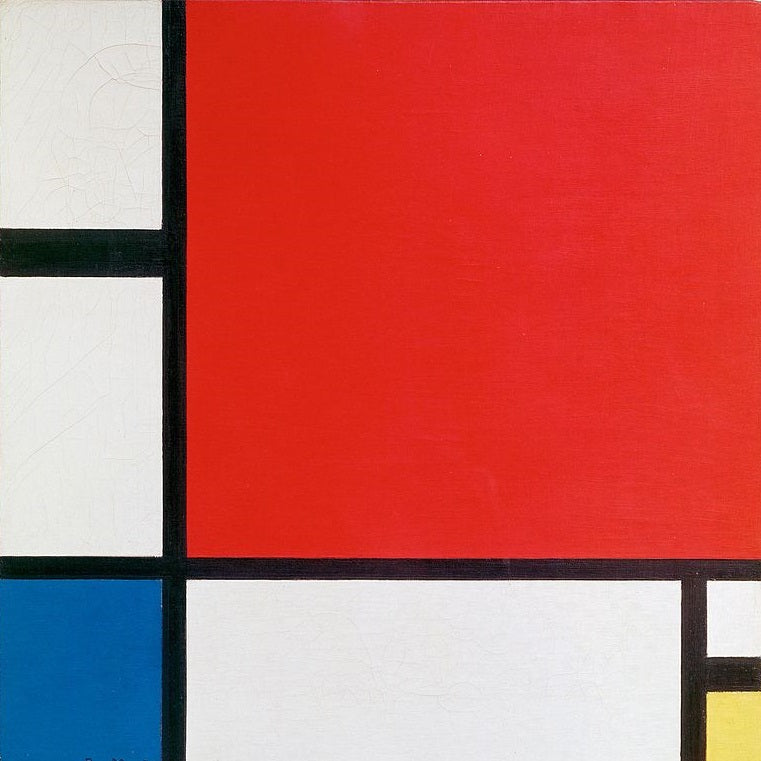
Composition II in Red, Blue and Yellow is a famous work by the Dutch artist Piet Mondrian, painted in 1930. This abstract painting belongs to the Neoplasticism art movement, which advocates a purely abstract art form based on simple geometric shapes and primary colours. In this painting, Mondrian uses black lines to divide the surface of the canvas into coloured squares and rectangles, dominated by the primary colours red, blue and yellow. This balanced and harmonious composition reflects Mondrian's unique aesthetic and is considered one of his most important masterpieces. The geometric simplicity and use of primary colours inspired many 20th century artists and designers, making Mondrian a major figure in modern art.
Date of the work : 1930
Original dimensions : 59.5 x 59.5 cm
Place of conservation : Kunsthaus Zurich, Switzerland
3. Gingerpot II
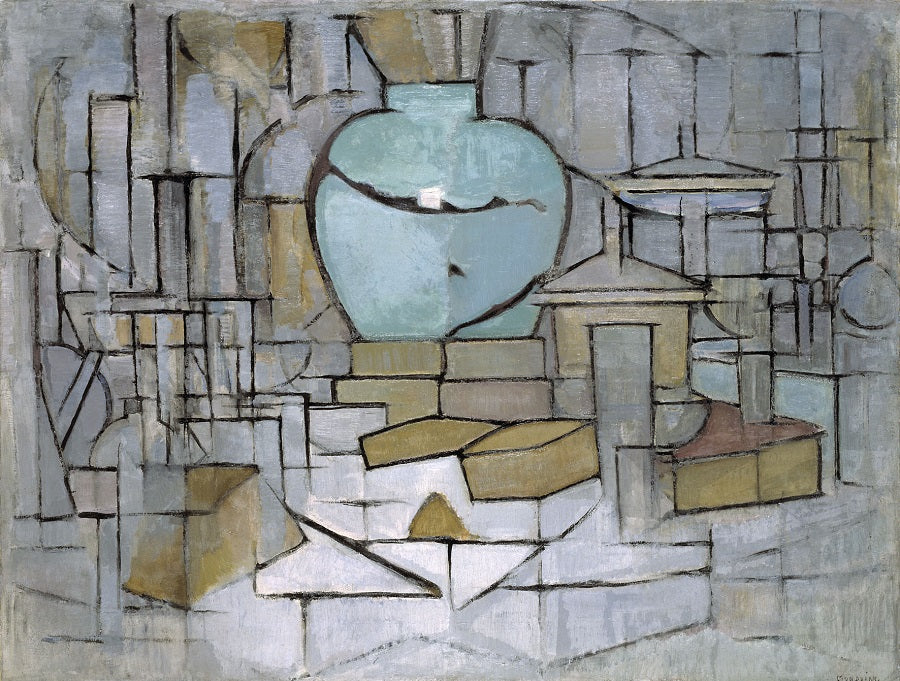
Gingerpot II by Piet Mondrian is a captivating oil painting from the early 20th century. This work of art features a dark green tabletop with bold yellow and blue lines superimposed on the paint. In this painting you will see geometric objects such as a white teapot, a red rectangular pot, five wooden chairs and two books outlined in blue and yellow that complement each other. The addition of subtle blues and yellows takes on an abstract form - brilliant in its ability to connect seemingly disconnected forms, creating an incredibly haunting atmosphere throughout the work. Gingerpot 2 was an important work for Mondrian and demonstrates his characteristic style well.
Date of the work : 1912
Original dimensions : 91.5 x 120 cm
Place of conservation : Solomon-R. Museum -Guggenheim, New-York, USA
4. New York City
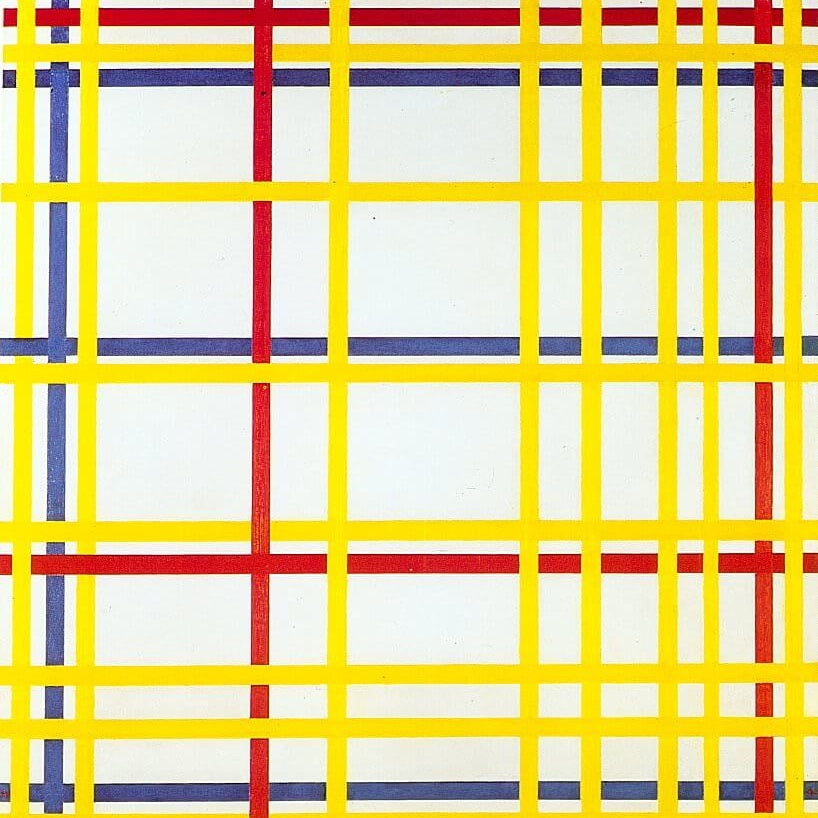
Piet Mondrian's painting New York City is an extraordinary demonstration of his artistic style. This 1942 painting has many classic characteristics of a Mondrian painting, such as vertical and horizontal lines, squares and rectangles in yellow, red, blue, white and black, arranged in various grids. The dark colours and heavy lines emphasise the vertical axis, giving the impression that the painting is rising towards the sky amidst the buildings of the city. This painting captures the energy and spirit that characterise the city so well.
Date of the work : 1942
Original dimensions : 119.3 x 114.2 cm
Place of conservation : National Museum of Modern Art, Paris, France
5. Broadway Boogie Woogie

Piet Mondrian's Broadway Boogie Woogie is a vibrant and exciting piece of modernist art. The painting is composed of intersecting black lines, angular shapes and blocks of primary colours, interspersed with small touches of secondary colours. These geometric shapes and bright colours create a playful atmosphere and give the painting a sense of energy that suggests a busy cityscape. This painting was created in 1943 to represent the new world of abstract art, incorporating influences from jazz music and the representation of energy. Its powerful imagery captures the frenetic life of New York City, allowing viewers to connect more deeply to its rhythmic energy.
Date of the work : 1943
Original dimensions : 127 cm × 127 cm
Place of conservation : MOMA, New York, USA
6. Gray tree
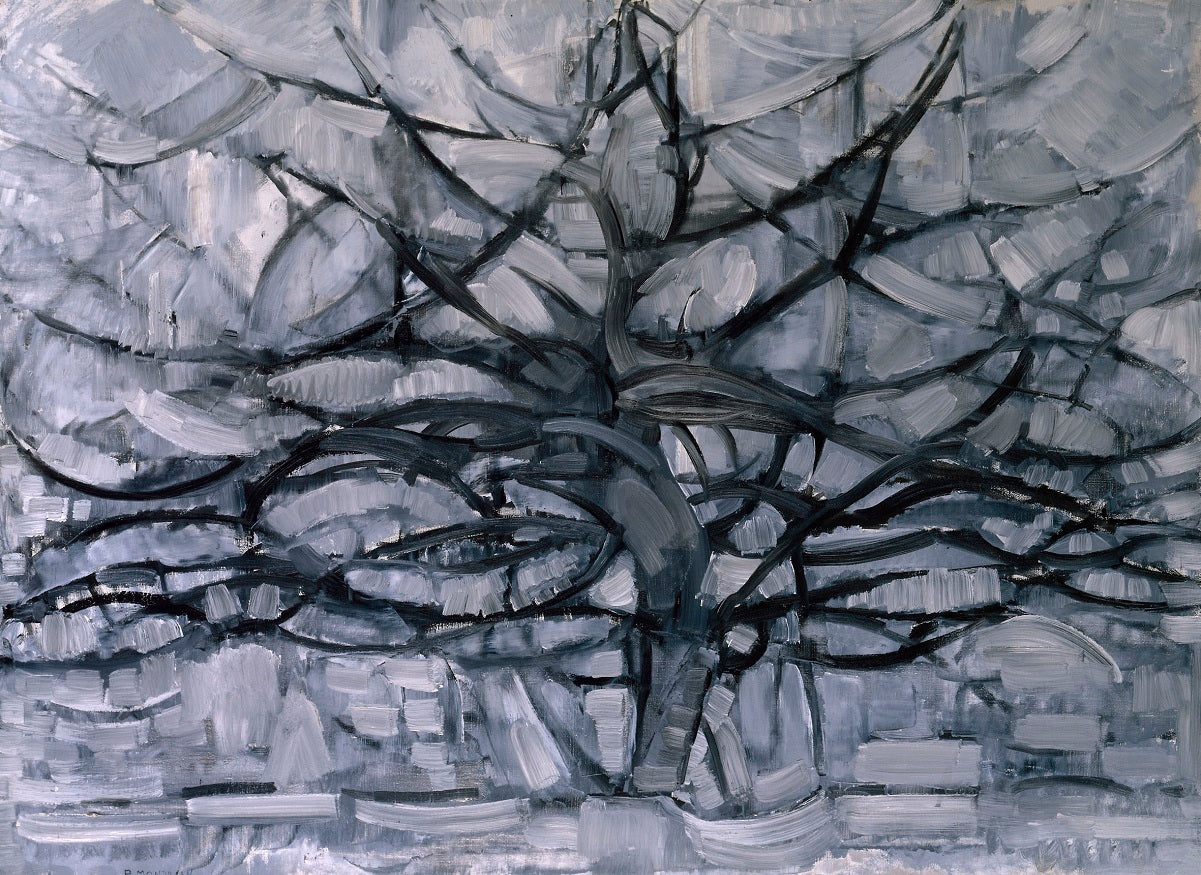
Gray Tree, painted in 1912 by the renowned Dutch artist Piet Mondrian, exudes a creative force of bold lines and a range of contrasting colours. Created in his early years, Mondrian's work expertly combines flat tints of cool purples and blues with an undercurrent of energetic orange hues that perfectly capture the interlocking nature of a tree's branches reaching for the sky. Substituting traditional painting techniques for pure abstraction, Gray Tree is a testament to Mondrian's quest for harmony between colour and line, which became the foundation of his Bauhaus-inspired neoplasticism in his later works. The work is an impressive testament to the power that simplicity can hold at its heart.
Date of the work : 1911
Original dimensions : 78.5× 107,5 cm
Place of conservation : The Hague Municipal Museum, The Hague, The Netherlands
7. The red tree
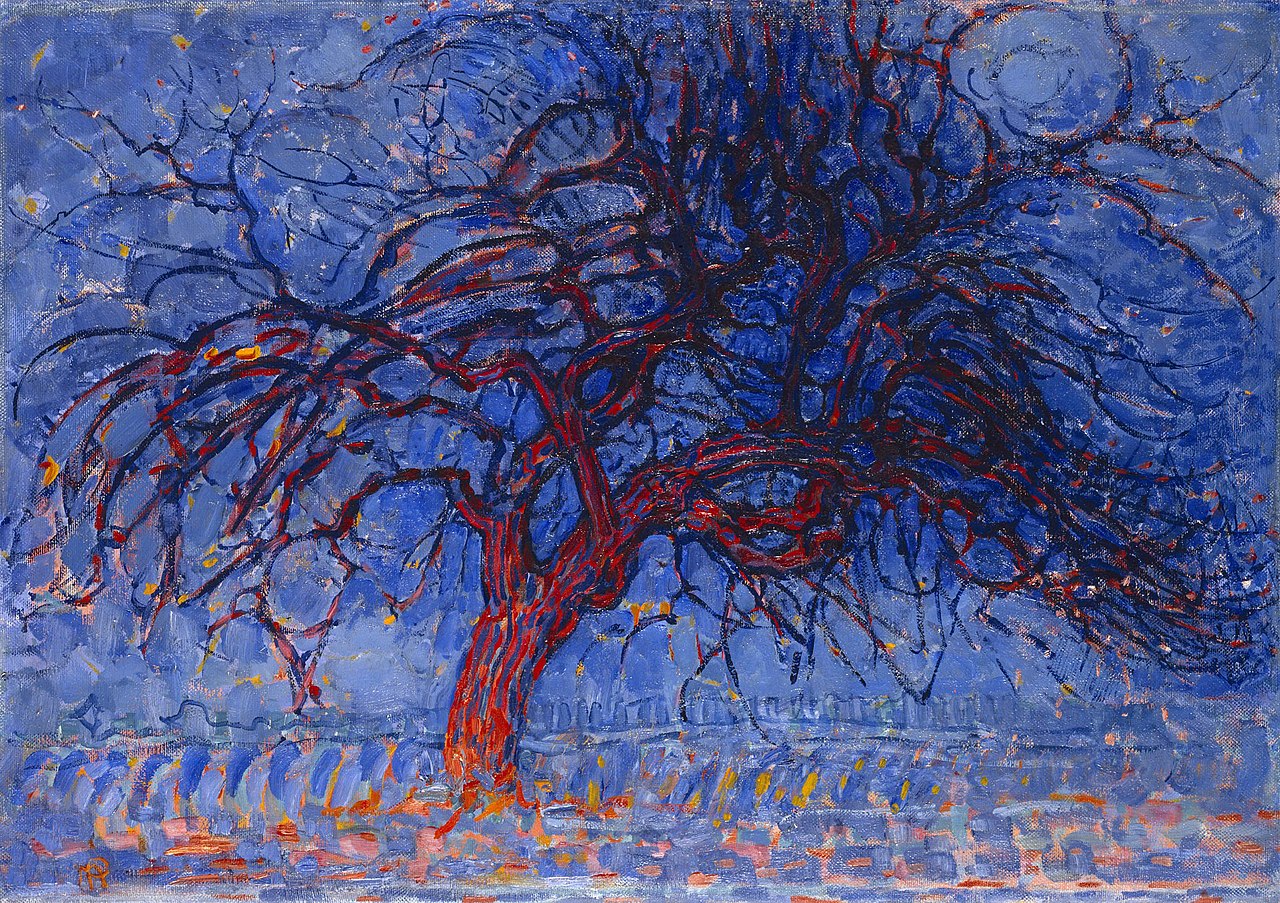
"The Red Tree" is a famous work by the Dutch painter Piet Mondrian, who belongs to the Neoplasticism art movement. This small painting (70 x 99 cm) was created in 1908 and depicts a stylised tree with black lines on a blue background. The particularity of this work lies in the use of primary colours (particularly red and blue) and the opposition of vertical and horizontal lines to create an abstract composition.
Mondrian was obsessed with the idea of simplifying nature through geometric abstraction. In 'The Red Tree' he used a technique called 'divisionism' or 'pointillism', which consists of dividing the surface of the canvas into small patches of colour. This creates an effect of visual vibration and gives the work a particular dynamic. The bright colours and black lines also give a certain tension to the composition.
"The Red Tree" is one of Mondrian's first paintings to show his transition to total abstraction. This work is emblematic of Neoplasticism, an art movement that advocated a purely abstract art form based on simple geometric elements and primary colours. Mondrian was one of the leading exponents of this movement and 'The Red Tree' is a perfect example of his unique and innovative style.
Date of the work : 1908
Original dimensions : 70 × 99 cm
Place of conservation : The Hague Municipal Museum, The Hague, The Netherlands
8. Composition 10 (Pier and Ocean)
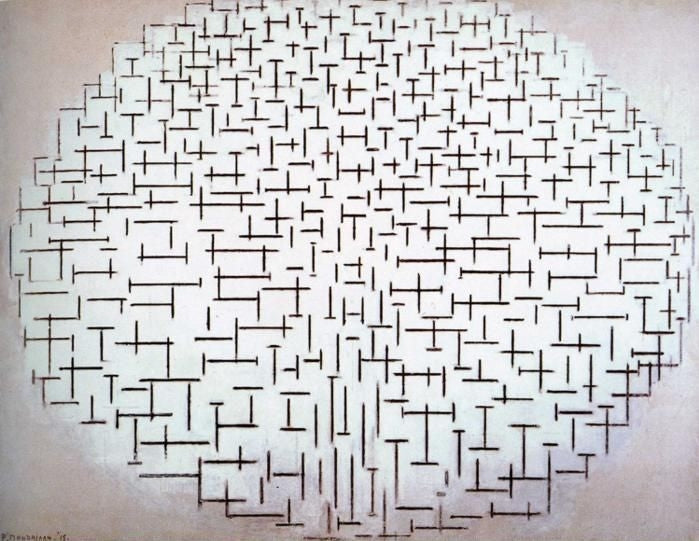
Composition No. 10 is a famous abstract painting by the Dutch artist Piet Mondrian, created in 1915 during his period of isolation in the Netherlands. He chose to depict the ocean using two colours: white and black, and simple horizontal and vertical lines. If you look at the painting closely, you can make out a pier going towards the horizon and the water with waves. This work belongs to the art movement of Neoplasticism, which advocated a purely abstract art form based on simple geometric shapes and primary colours. In Composition No. 10, Mondrian used black lines to divide the surface of the canvas into squares and rectangles. This work represents the culmination of Mondrian's unique and innovative style and is considered one of his most iconic creations.
Date of the work : 1915
Original dimensions : 85 × 108 cm
Place of conservation : Kröller-Müller Museum, Otterlo, Pays-Bas



